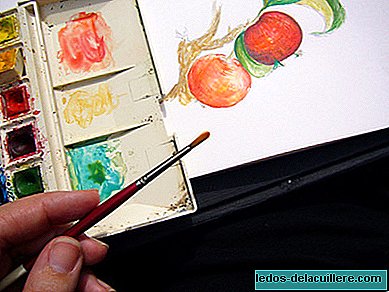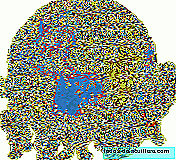
Today I brought you the second part of the post dedicated to writing in left-handed children, you will remember that I spoke to you a few days ago about the beginning of the writing, based on an article by Doña Mª Rosario Villagrasa Ballester. It reinforces the idea that left-handed children have a evolutionary development according to their age, and it is also taken into account that we should not allow the left-hander to be a problem for them.
In the previous article, we made a summary of the section dedicated to the “beginning of writing”, explaining (among other things) that it is children who define their own lateral dominance (10% of the population use spontaneously to write their left hand). The fact that someone prefers to write with the left should not motivate manipulations by the environment, but a good follow-up and care of the type of writing to be used, always thinking of providing help.
For today I have chosen a photo of someone drawing with the left, because although the post is dedicated to writing, left-handed people also use this hand for other more or less everyday activities. Let's talk about how to overcome the difficulties and the solution to the problems that arise, because we like to give a positive vision to this topic. On the one hand left-handed children are perfectly normal, and on the other they need support to overcome difficulties that are given by the fact that the rules in writing are intended for right-handed people, and nobody has planned that (because of their laterality) they require coordination and a good follow up.
Overcoming difficulties
Difficulties in writing lefties appear after months or years, it is not uncommon for children who attend the “reeducation of writing” consultation to be in the calligraphic stage of children (10/12 years).
At this time, the child should be consolidating their scriptural skills worked in the previous stage -Precaligraphic-, which normally lasts from two to four years, but their duration varies greatly according to the children, the school context in which they develop and according to the possibilities motor or intellectuals of the child
As a result of poor structuring, this child's writing does not reach the necessary levels of maturity and balance, causing him to show us a clumsy, insecure and childish writing. It is said that a child is dysgraphic, when the quality of his writing is poor, without having any neurological or intellectual deficit that explains it.
Generally, these children who come to the consultation are students who fail to overcome this stage and develop a dysgraph: we will say that a child is dysgraphic when, the quality of their writing is poor, there being no neurological or intellectual deficit that explains this deficiency
Since writing is only possible from a certain level of motor organization, a fine coordination of movements and a possible activity of these in all directions of space, we will say, then, that writing, conventional and codified activity, is the result of an acquisition and it is only possible from a certain degree of intellectual, motor and affective development.
The author of the original article tells us that the left-handed child rejects the written tasks, showing us a slow, clumsy and retouched writing, returning to what he has just written and, sometimes, reviewing whole letters, appearing atrophies in most of the letters and irregularity. All these manifestations are accompanied by intense shoulder, arm and hand pain due to the incorrect position of your body at the time of writing.
These problems are quite frequent in reeducation of writing and require practical solutions to be channeled from an exhaustive study of each specific case. The first step will then be consolidate lateralization so that dominance is homogeneous, training the dominant hand according to the acquired skills, looking for strategies to gain ease and speed and working techniques aimed at a correct placement of both the hand and the paper.
The solution to the problems
When, over the years, the left-handed child has been trying to accommodate the left-hander generally between the ages of 12 and 14, a stage of confusion which causes some confusion in both the child and his parents and teachers since his writing fails to overcome the previous scriptural stage.
It is in this case when reeducation becomes more precise, just when the child himself realizes his limitations, is when we must help him try to overcome them. Here we must ensure that the child acquires self-confidence, accepting his writing and looking for solutions.
We will propose exercises to achieve comfortable progression in writing, with cursive movements and free writing style monitoring the correct progression from left to right. We will look for agility, ovalization, simplifications, especially at the beginning of the word so that there is no drag. We will use all the means at our disposal that can improve the effectiveness of the left-handed child, providing ample places for him to perform the exercises: blackboard, continuous paper ..., as well as various writing instruments: brushes, paints, markers of different thickness and pen. Pointy feathers will be banished as they prevent displacement on paper
In general, and at all levels of writing, we will try in the left-handed child, as well as in the right-handed one, the adaptation of the method to follow in his scriptural reeducation is in each individual case, attending to his difficulties and providing him with techniques for overcoming the problem.
At the level of writing, left-handed people suffer a handicap due to the difficult conditions that arise in the graphic movement due to the use of the left hand, whatever the general difficulties. Cursive writing that progresses from left to right, in the horizontal plane is easier for right-handers because it goes in the natural sense of progression of the right hand.
The left-handed child covers what he writes as his hand advances. This difficulty causes a series of compensatory behaviors in the left-hander that are not always adapted to the circumstances, being able to choose, when the paper is straight in front of it, between:
- Crisp your left shoulder by bringing your arm closer.
Lean to the right to drag your arm and progress without twitching too much.
Stay straight, without twitching, although then "sweep" the line with your hand.
To avoid this last problem, some left-handed people place their hand above the line to free it. The arm and the forearm are separated from the trunk with wide rotating movement.
To address these problems, you must work the following aspects:
to) Hand position: hand below the line, hand above the line.
b) Paper layout.
C) Path Progression.
d) Forms of writing: vertical or leaning to the left.
For all those who are interested in expanding the information, I refer you to the article by Doña María Rosario Villagrasa, which is very extensive and clarifying.
After reeducation, you gain in speed, horizontality, ovalization and harmony, appreciating a huge writing evolution and disappearing painful phenomena by having avoided the tension in the motor plane.
At this time, the left-handed child acquires a taste for writing and expression, this being an important progress for his evolution in learning
Finally, we would like to thank the Institute of Psychographic Studies and the author for allowing us to reproduce this information.












